Update and Correction
|
Perhaps everyone knows that a slave flash is a flash that can be remotely triggered optically by another flash or by some radio devices. If you have a point-and-shoot camera that does not have a hot-shoe, slave flashes are very convenient because no wire and cord are needed. For some unknown reasons, Nikon dropped the salve capability from SB-26. In several years, Nikon has no flash with slave capability until SB-50DX, SB-30 and SB-80DX hit the market, although Nikon did introduce the wireless TTL-capable SU-4. Both the SB-50DX and SB-80DX can be used as TTL-capable slave units controlled by another Speedlight. However, the SB-30 is not TTL-capable, and can only be used in the A (i.e., automatic) mode and M (i.e., manual) mode.
In addition to Nikon's new slave-capable flashes, there are many other choices. First, there are many small flash units designed to work with any (i.e., well, almost any) film and digital camera. They are very cheap and portable. There are also third-party slave units such as the Digi-Slave product line. However, the most affordable ones may be the Sunpak Digital Flash and Sunpak DS 20. These two Sunpak units are similar and have a decent output power (i.e., GN 59 ft). Moreover, the DS 20 unit has a tiltable head for bounce effects. These two Sunpak units can be used in the A and M modes with a PC cable, as well as in the slave mode triggered by another, usually the internal, flash. Many of us may have a number of flashes for our film and/or digital cameras before picking up a Coolpix camera. Could these flashes be used as slave units? Of course, they can. In fact, some of these flashes may be Nikon TTL compatible. If not, there are small and cheap remote triggers available.
Are these slave units and remote triggers compatible with Coolpix cameras? Some are and some are not. This page reports some tests in order to determine if a Coolpix and a slave unit can synchronize properly. The tested cameras include 950, 990, 995, 2500, 4500 and 5000. Here is my conclusion:
| The 950, 990, 995, 4500 and 5000 work fine will all slave units and slave trigger devices tested. The 2500 has a flash system that is quite incompatible with non-Nikon products. |
In film cameras, TTL flash meter measures the reflection off the film plane and cuts off the flash power when the illumination is sufficient. The following image shows the rear-facing meter system of a Nikon F3. However, digital cameras have no film plane and the CCDs may not be reflective enough for metering purpose. To measure flash illumination, a camera fires the flash for a very brief period of time for metering purpose. Once the proper exposure is calculated, the flash fires again for image capturing. The first flash firing is referred to as preflash or pre-flash.
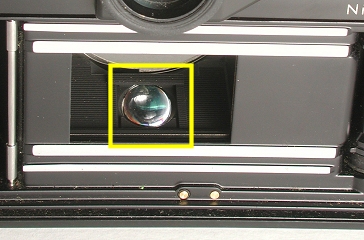
This preflash could cause problems because most slave units are triggered by another flash. If the preflash feature cannot be turned off, it could trigger the slave to fire prematurely. By the time the second and actual flash is fired, the illumination supplied by slave units is not there. Consequently, the scene is not illuminated by the slave units. Because the gap between the preflash and the actual flash is so short, human eyes may not be able to distinguish if a slave unit fires properly. Therefore, to determine if a camera and a slave unit can synchronize properly, what we really need to do is taking an image of the slave unit. If a camera and a slave unit synchronize properly, the image should capture the firing of the slave unit and a bright spot at the position of the slave unit should be recorded in the image.
Because the time elapsed between preflash and actual flash is so short, human eyes cannot distinguish if there are two flashes or just one. As a result, we may have a perception that the internal flash always fires. This is true to some degree, because the internal flash may only fire a preflash! Here is an example. We know that the 5000 uses preflash and, the internal flash fires a preflash even though a Speedlight is mounted and activated. This would give us an impression that the internal flash fires when it is turned off. The first image is the mirror image of a 5000 with SB-28. The second image below is the mirror image obtained by turning the internal flash on and the external flash off. Of course, the bright spot is the second flash of the internal flash. Now, we turn on the SB-28 (external flash) and set the Speedlight Opt to Auto. This option means that if an external flash is attached, the internal flash is turned off. The mirror image is shown in the third image below. It is clear that the image captures the firing of the external flash SB-28 and the internal flash does not provide any illumination. If you look at the internal flash carefully, you will notice that it does fire! However, it is a preflash! The internal flash does not fire the second time. Whether this is a good design (i.e., the internal flash always fires a preflash) is not the subject of discussion of this page. If the Speedlight Opt is set to Int & Ext Active, the mirror image shows that both flashes illuminate the scene as shown in the fourth image below.

|
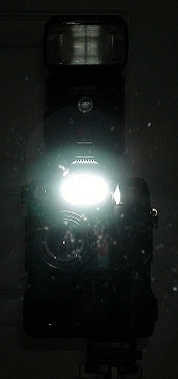
|
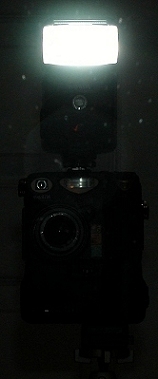
|

|
| No flash | Internal flash only | The Auto mode | The Int & Ext Active mode |
My testing procedure is very simple. The slave units being tested are placed on a bookshelf. Each testing camera uses the longest focal length (so that the camera can be moved away from the flashes to avoid ``white-out''), the smallest aperture if applicable, the manual mode and the Anytime flash setting (i.e., the internal flash always fires). Since these slaves are triggered optically by another flash, the internal flash will trigger all of them. Our goal is to determine if a slave unit fire properly. Whether the image is well-exposed is not our concern.
There are some very simple and low power mini slaves available with a price tag between $10.00 and $30.00. The following shows three such mini slave flashes. The left one is Morris Mini Wide Plus and the other two are cheap pocket size slaves.
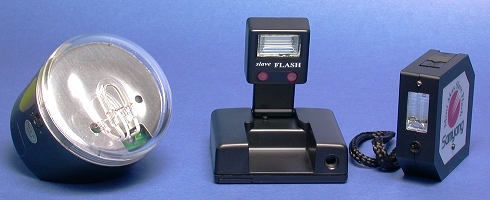
The following images show the result of 950, 990, 995, 2500, 4500 and 5000. It is obvious that the 950, 990, 995, 4500 and 5000 all work fine with these three slave units because three bright spots show up in each image. The 5000 image here shows that all three slave units are activated. However, the situation is not all that uniform. The 5000 and Morris Mini Wide Plus sometimes do not synchronize properly, and, hence, the 5000 does not capture the firing of the Mini Wide Plus. The major reason is perhaps due to the light incident angle. Therefore, additional tests are required. The worse case is that of the 2500 because its image is completely black. However, all three slave units and 2500's internal flash did fire. Maybe the strong illumination from the three slave units confused 2500's flash sensor. If the slave units are not facing 2500, 2500 can indeed take flash images with its own internal flash. However, the 2500 and the slave units do not work together properly.
| 950 | 
|
| 990 | 
|
| 995 | 
|
| 2500 | 
|
| 4500 | 
|
| 5000 | 
|
Although slave flashes may not be very popular among Coolpix users, they do provide extra flash power when the internal flash is not good enough. The drawback of using a slave flash is that the internal or an external flash must fire to trigger the slaves; however, no flash cable is needed. If the small slaves are too weak, there are some not-so-expansive slaves with reasonable fire power. Nikon's new SB-30, SB-50DX and SB-80DX have wireless remote sensors and can be used as slave units. Sunpak released Digital Flash some time ago (below right). The recently released Sunpak DS 20 is almost identical to the Digital Flash (below left); however, its flash head is tiltable which is definitely an improvement. They are cheap, too. The average retail price is perhaps less than $30.00. These two Sunpak units can be used in the manual (M) mode, automatic (A) mode, and slave mode. They are also small and easy to carry around. Moreover, the popular high power Sunpak PZ5000AF has a slave mode. The next test determines the compatibility of these popular Sunpak units. All of them are set to the slave mode.
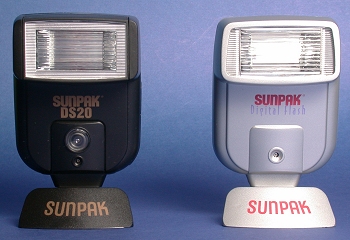
The following shows the test results. The flashes, from left to right, are Sunpak DS 20, Sunpak Digital Flash and Sunpak PZ5000AF. As in the small slave case discussed earlier, 950, 990, 995 and 4500 all work fine with these Sunpak units. The Sunpak Digital Flash and Sunpak DS 20 do not synchronize with the 2500. Again, this may be due to preflash. The Sunpak PZ5000AF does work fine with all cameras in slave mode, although it is known that the PZ5000AF does not work with 5000 very well in non-slave mode (i.e., one must reset the PZ5000AF after each firing).
| 950 | 
|
| 990 | 
|
| 995 | 
|
| 2500 | 
|
| 4500 | 
|
| 5000 | 
|
Finally, we test two remote trigger devices: Nikon's SU-4 wireless slave flash controller (left below) and Vivitar SL-2 remote flash trigger (below right). Click here to see more about the SU-4. These slave trigger devices are particularly useful if you have already had a flash, dedicated or non-dedicated, in your collections, because we can mount a flash on the hot-shoe to make it a slave flash. In this test, a SB-22s is mounted on the SU-4 and a SB-28 on the Vivitar SL-2.
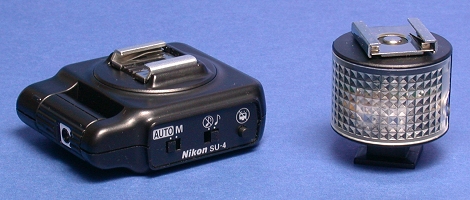
The SB-80DX, SB-50DX and SB-30 have a built-in SU-4 and the Sunpak PZ5000AF also have a slave mode. Therefore, it is worth to also include these flashes. In our test, the SB-80DX and SB-30 are set to the wireless A mode because this is the only mode that the 2500 can use. Note that although SB-80DX, SB-50DX and SB-30 are TTL-capable and can fully synchronize with Nikon's film cameras, they do not synchronize with all Coolpix cameras. As a result, the SB-22s, which is used with a SU-4, is set to the A mode with an aperture of F11. The SB-28 and Sunpak PZ5000AF are set to the A mode and the slave A mode, respectively, with aperture F11.
These fives flashes are arranged as follows: the top row has SB-80DX (left) and SB-28 with SL-2, and the bottom row has SB-22s with SU-4 (left), SB-30 (middle) and Sunpak PZ5000AF (right). The following are test results. As you can see, all cameras work well except for the 2500. The 2500 only works well with the SB-28 plus SL-2 combo!

|
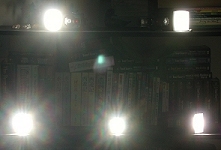
|
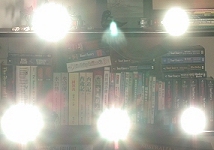
|
| 950 | 990 | 995 |

|
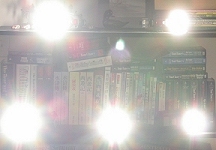
|
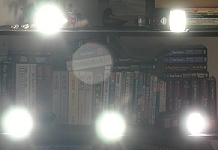
|
| 2500 | 4500 | 5000 |
We just mentioned that, according to SB-30's manual, the wireless A mode works with the 2500. But, the illumination of the SB-30 is not captured in 2500's image even though all other five flashes do fire. One of the many possible reasons may be that the light sensor window for wireless slave flash (see below) is very picky and directional. It must face the 2500's internal flash properly at some angle. If this angle is not right, the SB-30 will flash but may not synchronize properly, and, as a result, the 2500 will capture an under-exposed image. In fact, the SB-30 may not synchronize well sometimes when it is placed side-by-side with the 2500. In terms of convenience, the SU-4 is much better because its base can be rotated to point to the master flash. As a matter of fact, the 2500 and 5000 both work well with the SB-28 with SU-4. For the case of 2500, if the SU-4 can pick up the firing signal, one can hear two clicks from the SB-28, indicating that the flash fired twice. So, the flash system of the 2500 must have something very strange. In my opinion, the SB-28 and SU-4 combo is still the king of wireless flash for the Coolpix cameras.
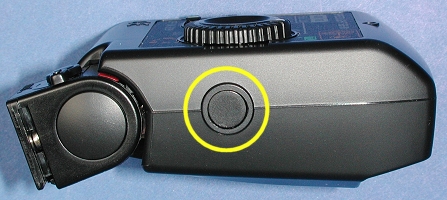
|
| SB-30's light sensor window for wireless slave flash |
There is a very cheap way to trigger a flash remotely. The Wein Peanut costs less than $15.00. It serves the same purpose as Vivitar SL-2; however, it is not as sensitive as the SL-2. The Peanut is very small with a diameter approximately less than 15mm (below left). It can be plugged into flash units directly or cores fitted with a standard PC terminal. The left image below shows the terminal/cord connector, while the right image below shows a Peanut connected to a PC cord. Test results indicate that the Peanut works fine with all cameras except for the 2500 and 5000.

|
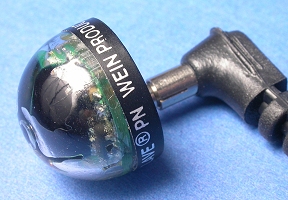
|
Many forum goers may see some messages recommending the use of slave units, notably the Sunpak DS 20. As the test results show, you perhaps will not be able to get any good result if you have a 2500. However, the users of 950/990/995/4500 do have a wider choice as all tested slave units work fine with these cameras. My conclusion is that test before you buy. Here "test" means shoot the slave unit with the internal flash on. That you see the slave fires does not mean your camera can capture the slave's illumination. A slave flash does not work with your camera if your camera cannot capture the firing highlight of the flash.